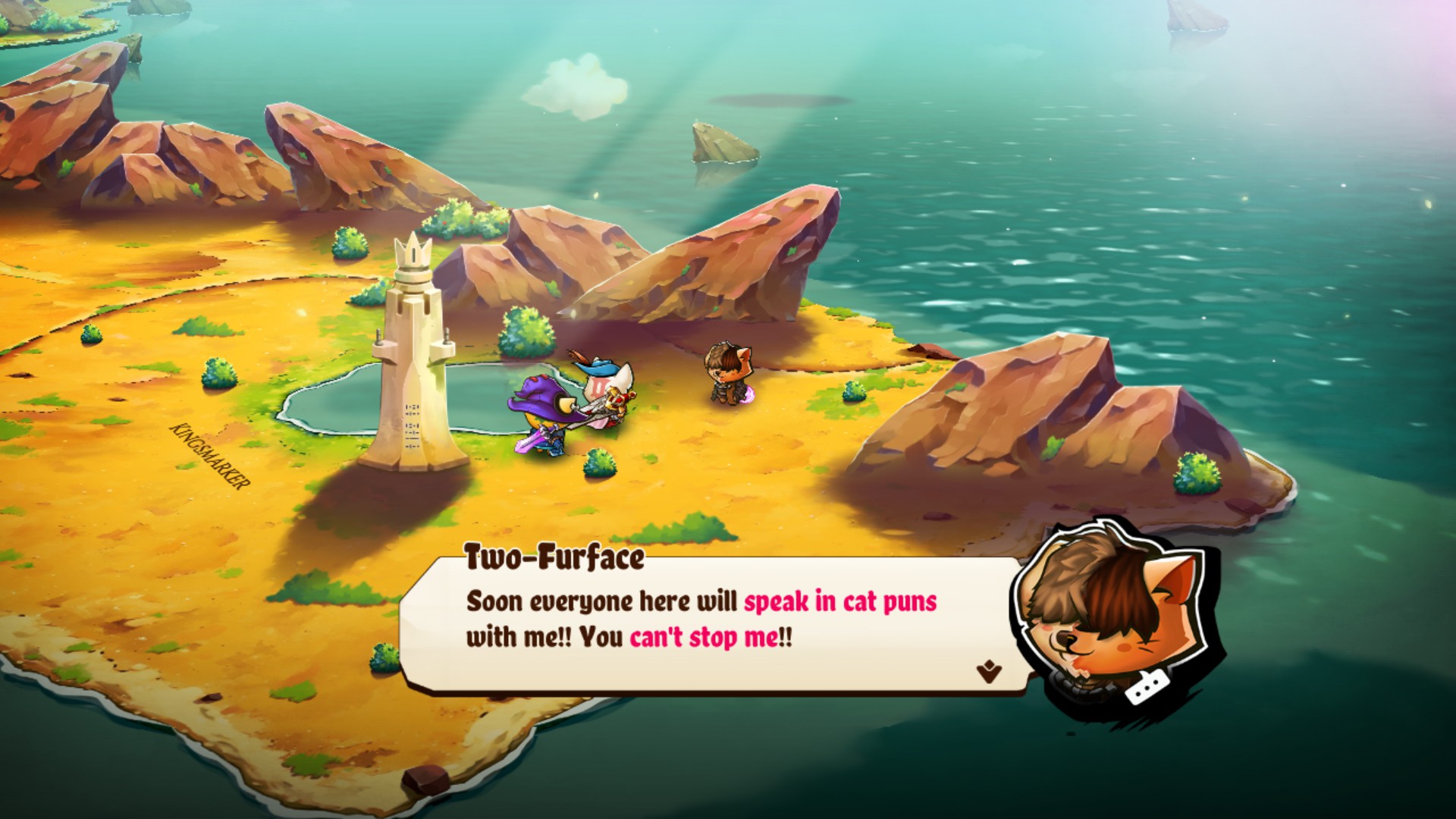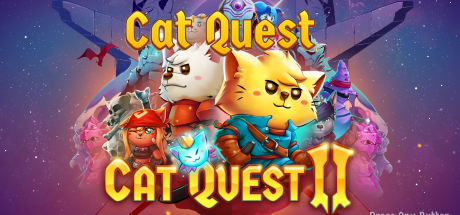If life didn’t have enough cats and dogs, then these two hack-and-slash adventures will be the purrfect cur for your problems.
Type: Single-player, Local Co-op
Genre: RPG, Action, Dungeon Crawler,
Developer: The Gentlebros
Publisher: PQube Games
Release date: 24 September, 2019


Cat Quest: Back to Where It All Furst Began
With the release of Cat Quest 2, it’s difficult to share the same adoration for its predecessor after having played something that takes everything the previous game did so well, yet simply does the same concept so much better. Thankfully, with the release of the Cat Quest 1 & 2 bundle at a reasonable price, I can happily recommend the original as much as the sequel—but it’s quite clear which game is superior. (Psst, Gentlebros, if you were to recreate Cat Quest in the sequel as DLC with reworked dungeons and the same quests and story, I would happily buy that day one.)
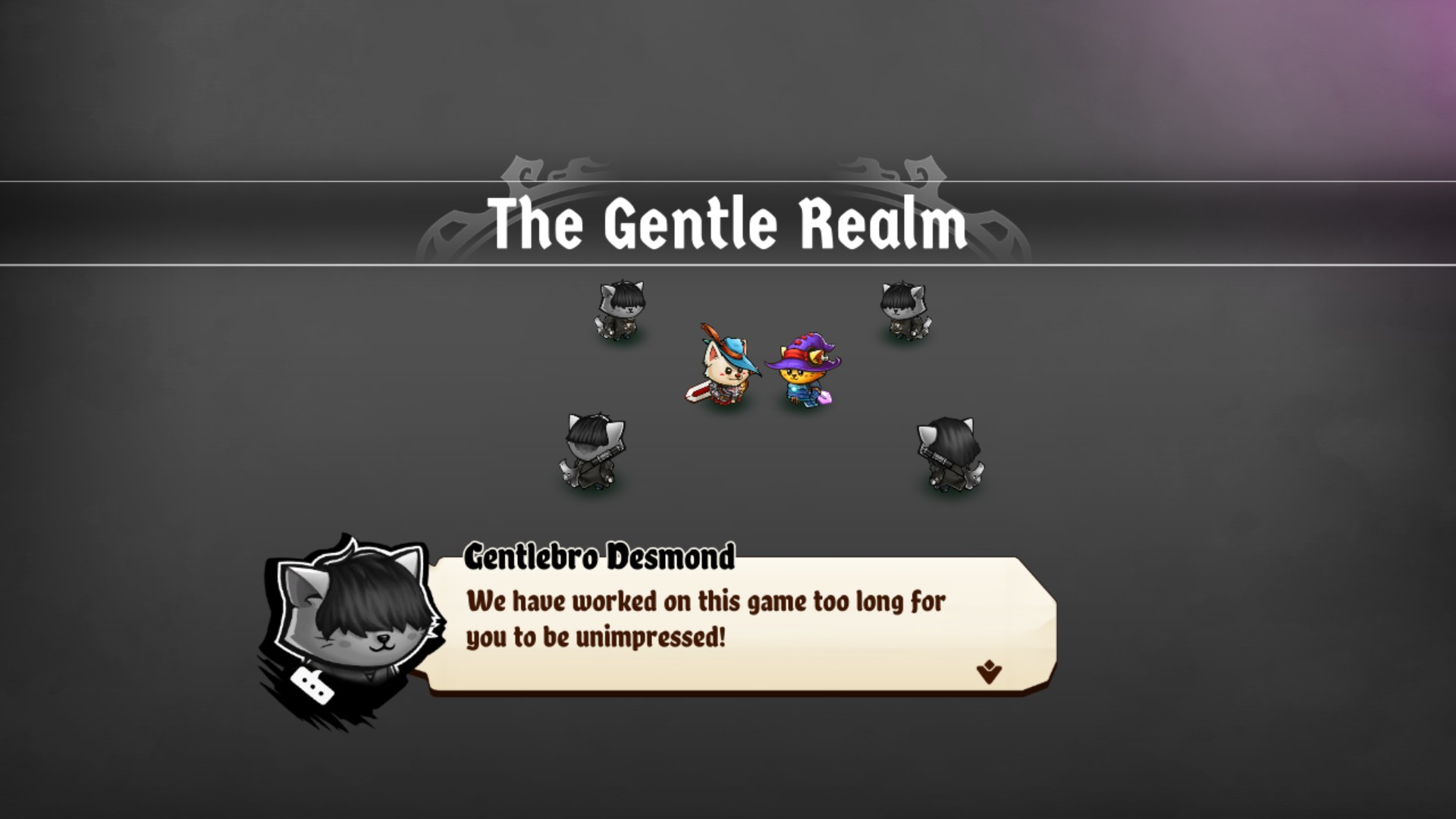
Anyway, in preparation for the sequel, I first played the original before and after several hours with its next installment; the purpose was to view both games as fair as possible while also acknowledging each game’s strengths. If you were to ask me what my expectations were versus the reality of the situation, my assumptions were that Cat Quest 1 and 2 were both equally good games with their own ideas much like Torchlight 1 and 2. However, while both games are equally fun in their own ways, a more proper comparison is to compare Cat Quest 1 and 2 as Diablo 1 to Torchlight 2 respectively. Once you have played something with a similar schtick, an updated take can often make any lessons learned all the more obvious much like a dog discovering that anything can be used for fetch when someone wants to take it from you.
There is One They Fear; In Their Tongue, He is Called… Dovakit
You know, one of the first thoughts that ran through my mind, starting off as a joke before solidifying as a fact with time, is how much Cat Quest feels like Skyrim except with more cat-people. In other words, you can say the Gentlebros went elsewhere for ideas. It would honestly not surprise me if there was a design document somewhere that had these sentiments written down as one of the core tenets for Cat Quest because so many ideas can be traced back to that game.
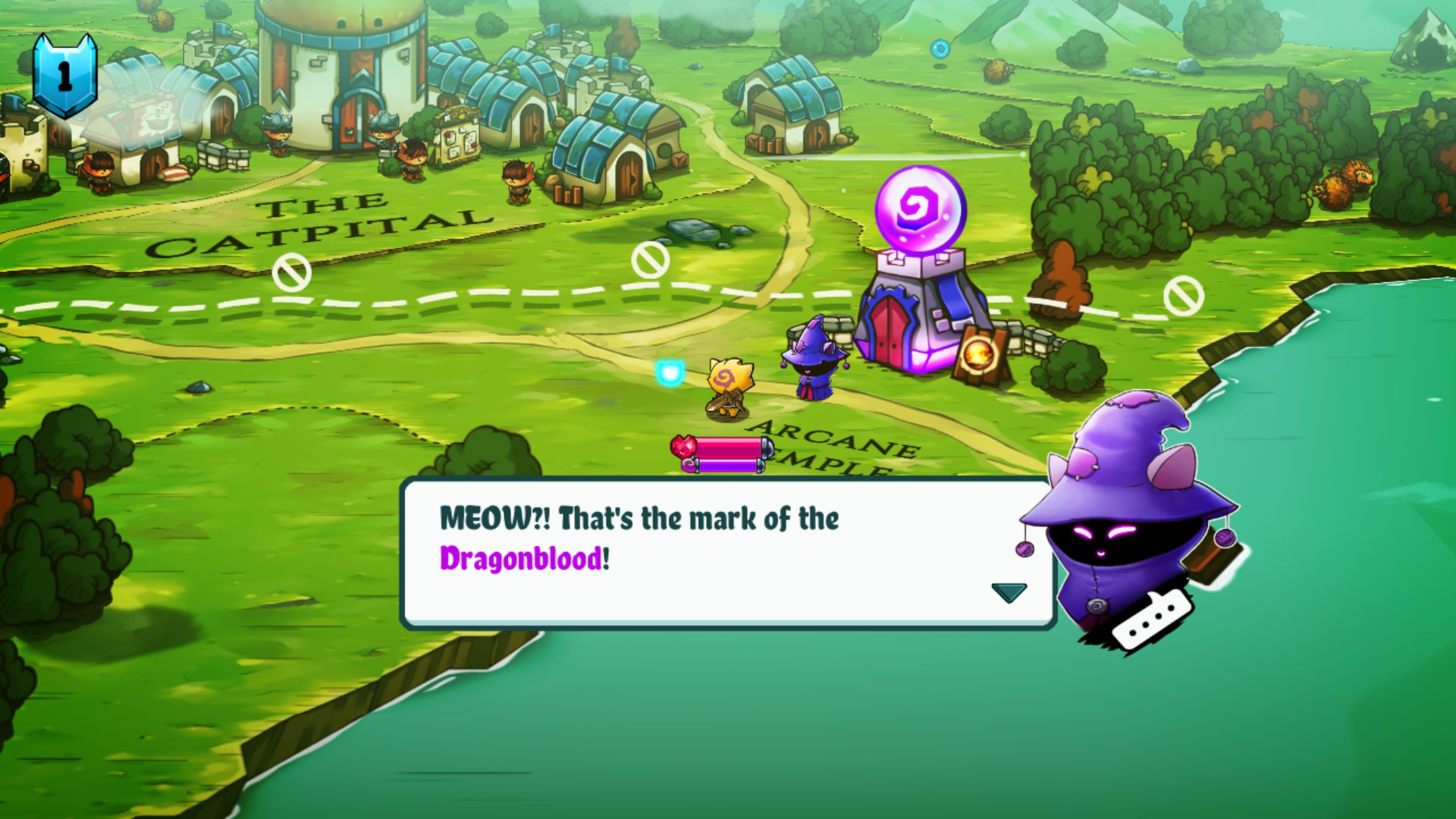
If that comparison sounds like a complaint that the game is unoriginal, then that’s not my point. Granted, there are obvious differences that won’t appeal to everyone; the isometric, fixed camera; the more simplified gameplay; the mobile concessions; and the more laxed, self-aware narrative are all elements of its own creation. Ignoring these obvious points of contention, what makes Cat Quest resemble Skyrim is that addicting core gameplay-loop of exploring dungeons, finding loot, completing side-quests while wandering the world, and then repeating the same process in a random manner with constant positive reinforcement (or you can call it pun-ishment.) Even the fact that the story centers around you, the Dragonborn, fighting off the dragons’ return can feel like a wink to the audience. Instead of viewing Cat Quest (or Skyrim) as an RPG, which I would argue it is not, it’s more accurate to describe the game as a grinding game where the RPG progression is its own cathartic pleasure.
Having described Cat Quest in such a generalized manner for its intended audience, it would be helpful to illustrate those deviations in greater detail. First, the camera differences are apparent enough, although the drawbacks are less obvious until you have played the game for several hours. One common problem is that magical spells and damage numbers will clutter up the screen, making it more difficult to avoid taking damage once you have more than one enemy casting spells, especially when the enemy is also physically attacking you. Another somewhat related matter is that when you attack, your character sometimes snaps between more than one target, which puts your character at greater risk. As a result, the player’s hit-box can often feel as exceedingly generous as much as it will often feel unfair. If you only play this game on the default setting, then this problem can be circumvented with enough armor, but the flaws of this camera and combat system become more of an issue on Mew Game plus.
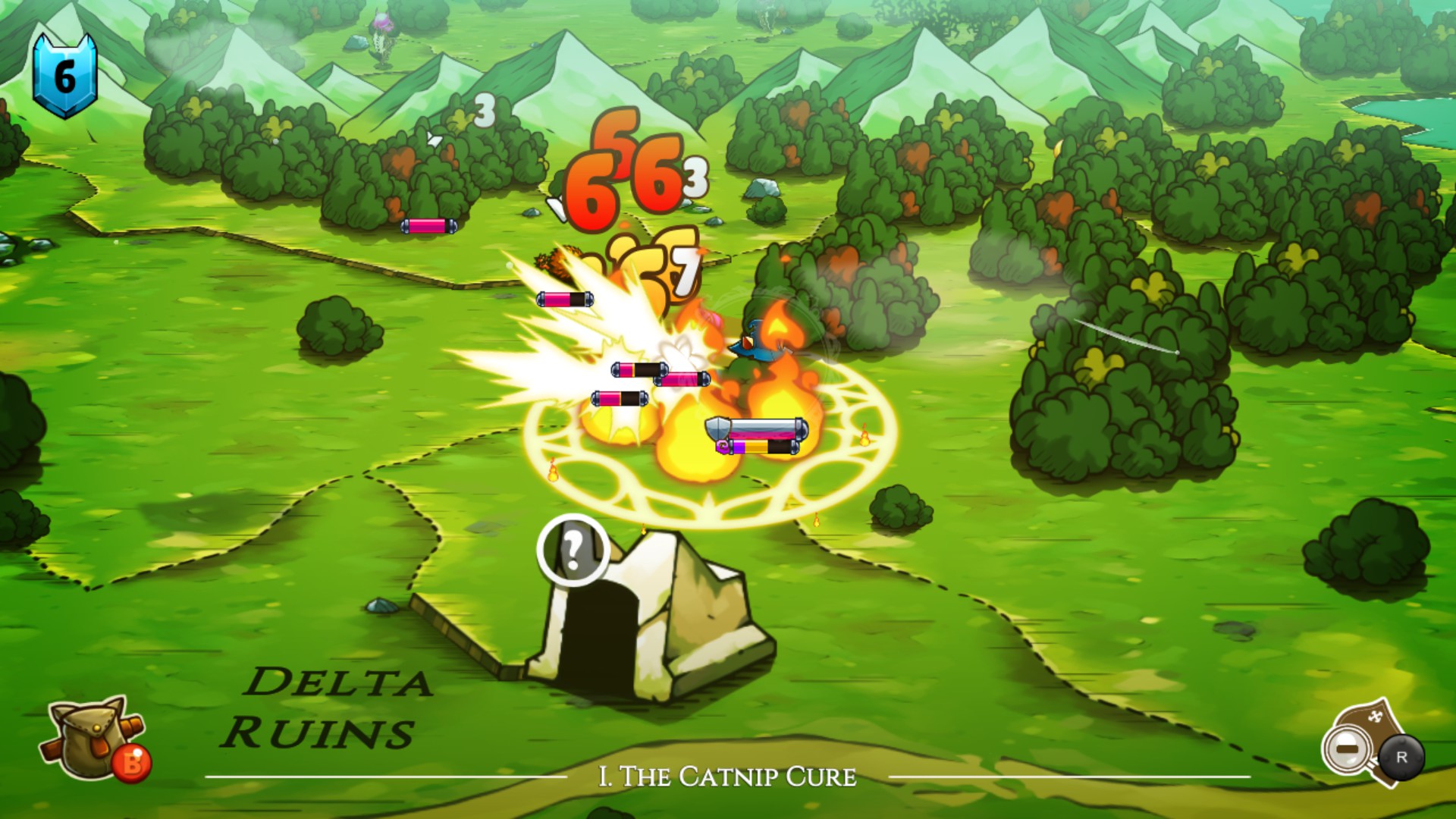
While these concessions are likely due to the fact that the game was originally intended for mobile devices, it’s quite an accomplishment that the rest of the game has enough attention elsewhere to make the game feel like a proper PC port. Menus have complete keyboard and mouse support and you can even use spells just like the mobile version by pausing time to select the right spell, or you can simply hit the hotkey to keep the combat pace intact. The only noticeable aspects that betray the quality of this port is that your options are limited to screen resolution sizes, there is an annoying faint circle around your character, and you cannot rebind the keys. Thankfully, these latter two problems have been addressed in the sequel as well as another mobile influence: Lootbox-based rewards.
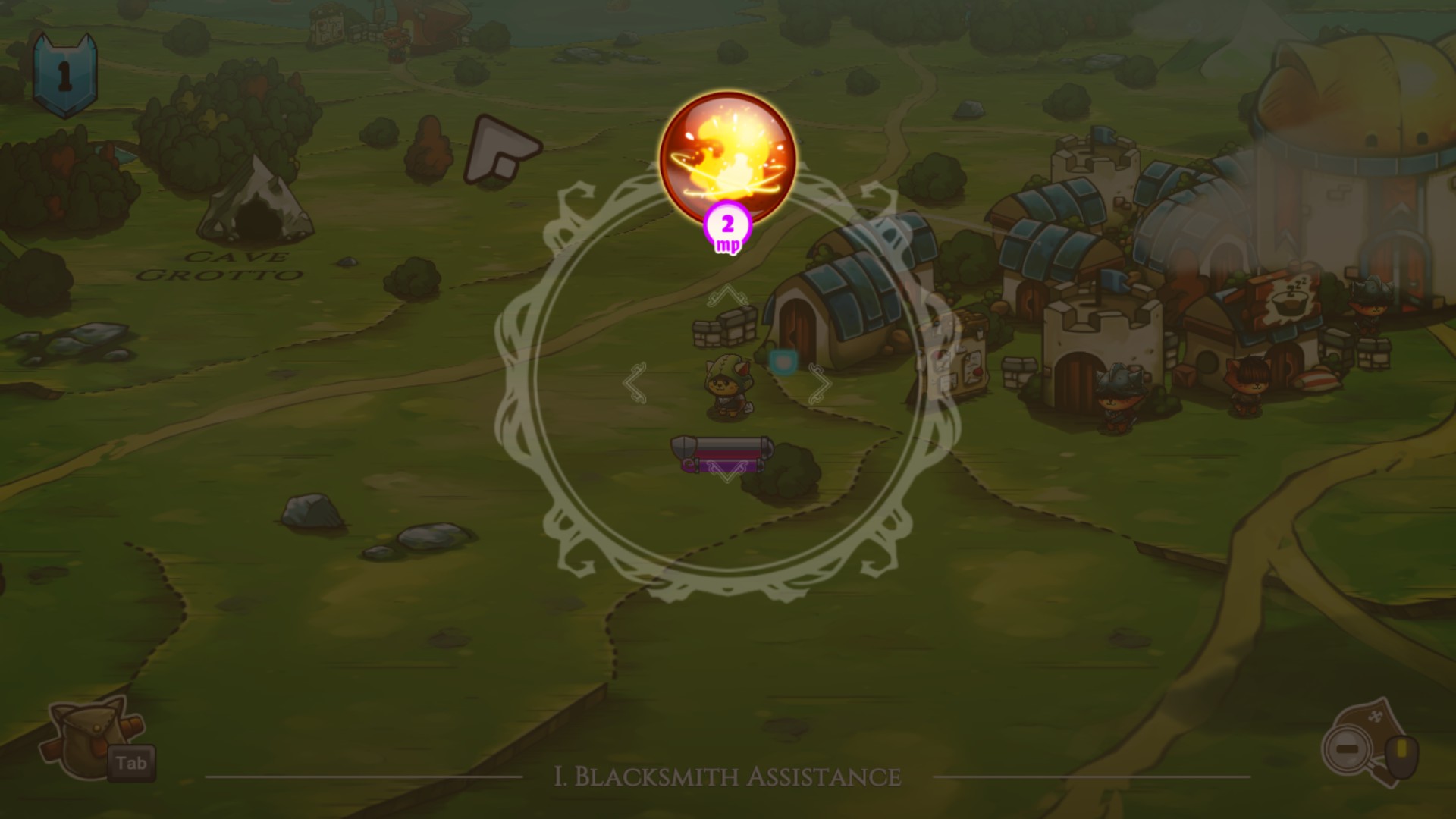
Now before you abandon ship like a scared cat jumping at its own shadow, these loot boxes are not purchasable outside of the game; they are all in-game rewards randomly given to you in dungeons or at Kit Kat’s shop for in-game gold. The game also offers golden chests for another randomized selection of higher quality equipment scattered throughout all the land and the dungeons, but you need a key from a certain island that won’t be accessible until you can learn to walk on water. This aspect only adds more needless backtracking to the game and I’m glad the sequel made them less important in favor of adding more hidden chests or a reward for killing all the enemies in a dungeon. However, one thing the sequel could have included was some monetary reward in addition to the higher-tier items to encourage players to level up these mid-to-late-game weapons.
The problem, and some might say the thrill, with this system is how much randomness it adds to the game to make repeatable runs enjoyable. Maybe this dog here is getting too old for you darn mewling kids because this system feels catered to audiences who want to always chase after another reward rather than make the most of what you have. Some games benefit from the added RNG like Torchlight, but Cat Quest is a case where the surprise gets in the way of your adventure. Sometimes you will simply get literal crappy weapons, and other times you will get upgrades to equipment you no longer want to use. Unlike the sequel, there is no method to properly improve or farm one particular set of gear, which makes the game too artificially difficult for my liking.
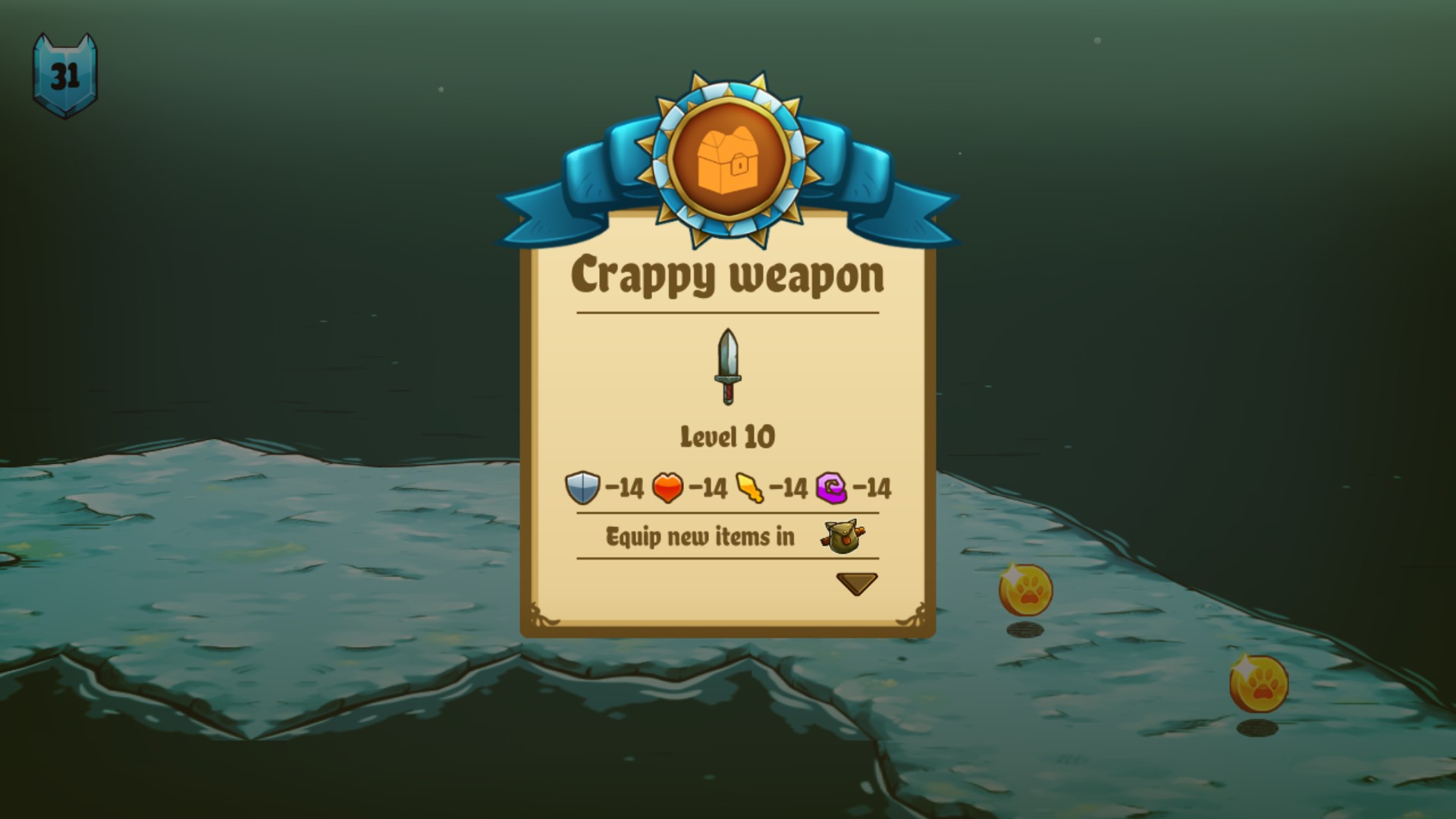
While there is mostly a randomized set of loot throughout the entire game, there is another cache of gear that is more consistent: side quest rewards. Unfortunately, those items don’t appear to be influenced by the level that you perform the task, so if you neglect a side-quest until much later into the game, you might come across some good gear that is far too under-leveled to use. Again, this problem is fixed in the sequel since you can spend your gold on these side-quest rewards to bring them up to par with the rest of your equipment. The importance of understanding this system is that Cat Quest is a surprisingly difficult game if you aren’t properly maintaining your gear, which is given more importance in Mew Game plus if you enable the Level One Forever modifier.
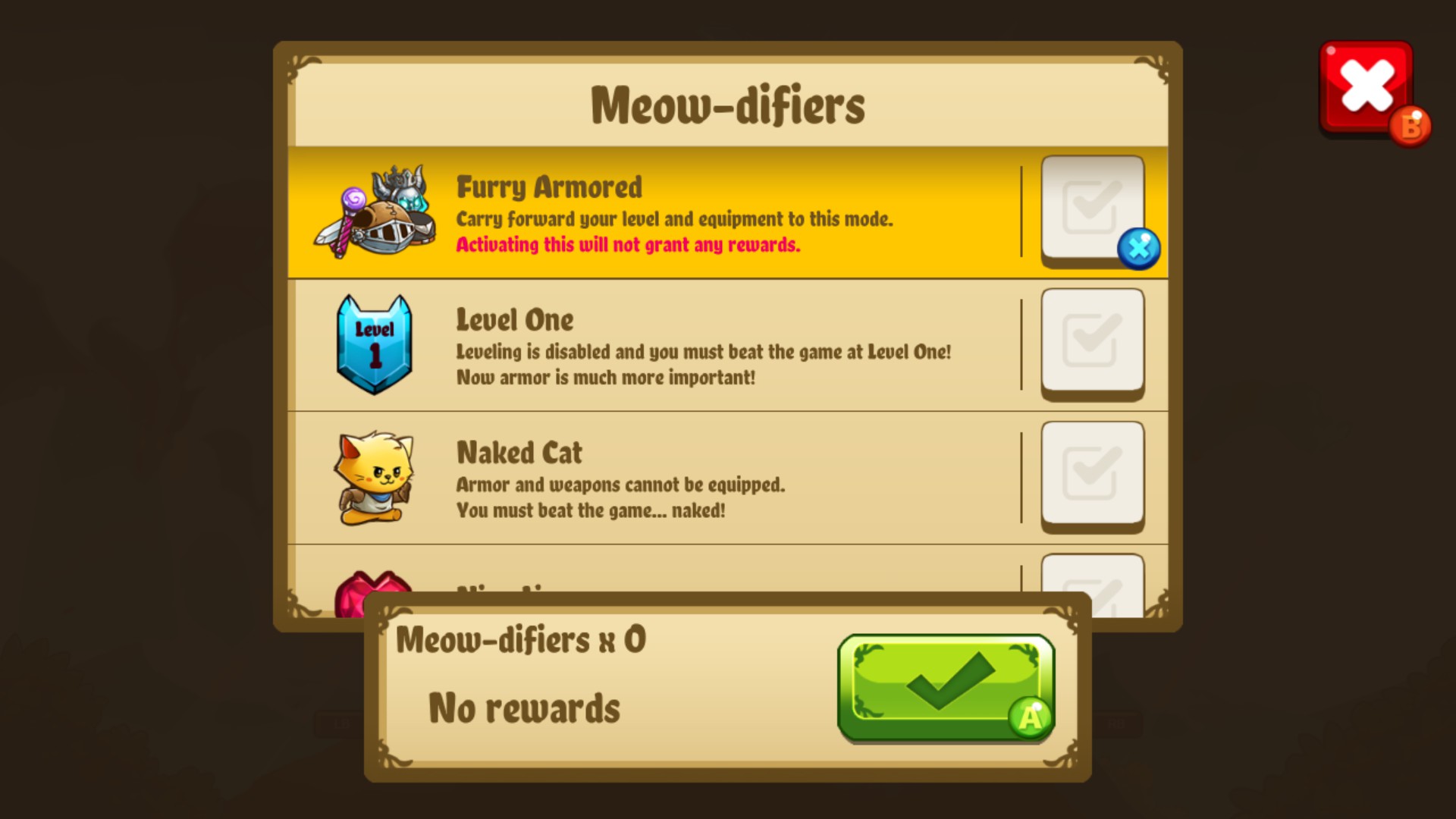
At first glance, you wouldn’t expect Cat Quest to be anywhere near as difficult as it really is; however, as I have illustrated throughout this section, it’s the many problems with the progression system and the core gameplay that makes the game more difficult than it should be. Perhaps this statement might help others understand why some players believe Cat Quest 2 is easier than the first, although there are balancing issues in that game such as the fact that staffs do far more damage than melee weapons. From my experience, both games are equally challenging while never making the game too easy nor too difficult without the right equipment. When everything does come together, especially in the story department, the friction caused by its own attempts to keep everything balanced always falls short of whatever offers the player the least resistance, which in this case is the lowest mew. (That was a physics joke in case that one had no momentum for you.)
The More You Look at the Audience, the More that Abyss Looks at You
Between the two entries, Cat Quest doesn’t come anywhere near to a cohesive story much like Cat Quest 2, which is probably what the developers originally had in mind. One half of the adventure is solely focused on lampooning videogame tropes from absurd quest-objectives to blatant references to nostalgic videogame icons. The other half is focused on expanding the mythos of the world as well as the backstory behind the adventure, which is also full of many fourth-wall-breaking moments of its own. The result of these metaphysical disruptions is that the player never quite builds any emotional attachments with the world because they are constantly shown that it is purely artificial.
The question that should be asked is, “Is this problem really a problem for the game, or are you finding another mound of sophistry from the litter box?” The answer to both questions is yes, although that is definitely one way to reconsider how I view the literary department.
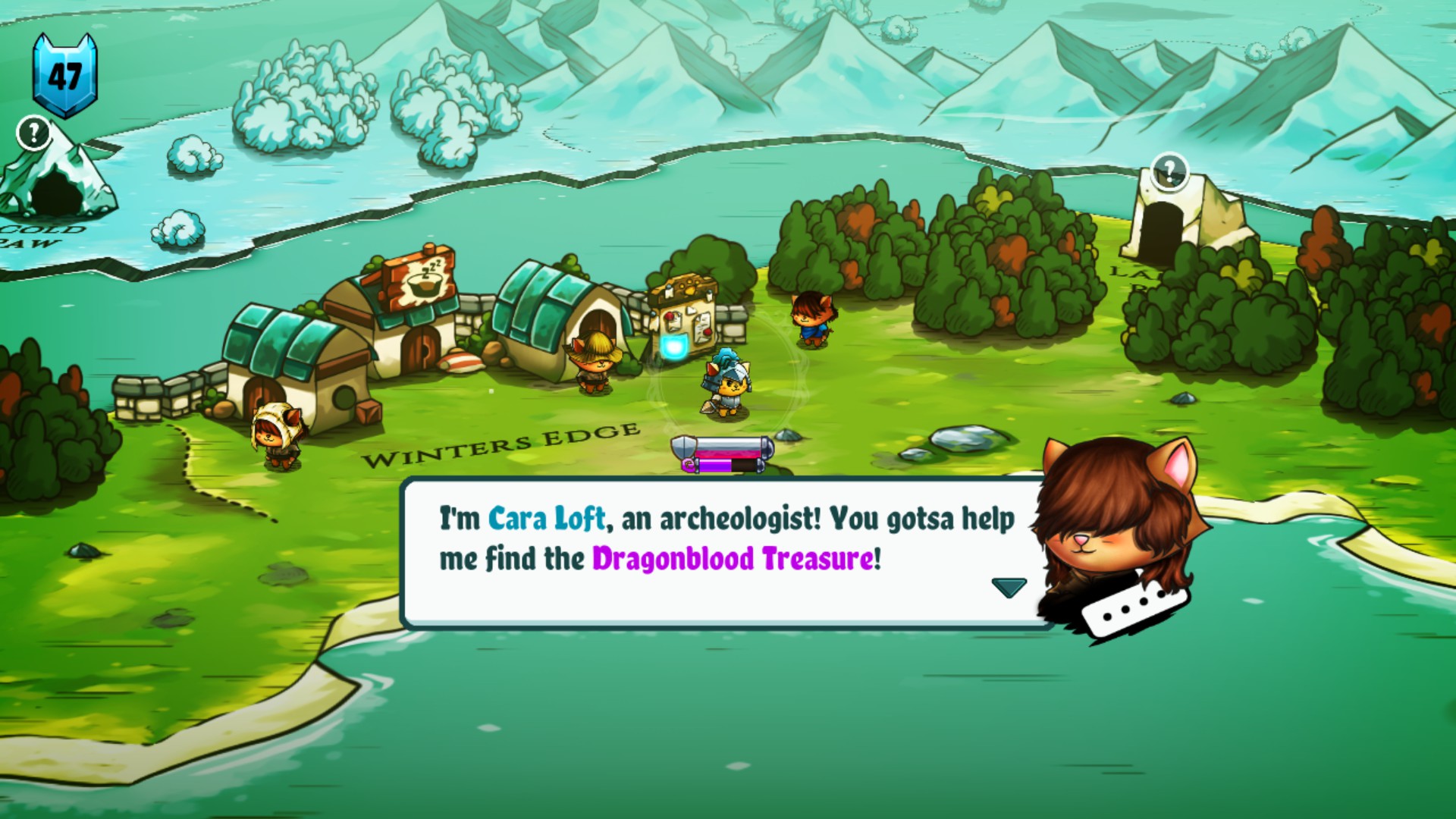
Cat Quest is simultaneously an example of how to use tropes correctly and when you are using them to excuse poor decisions. As a game meant for children, Cat Quest fulfills its role for keeping younger audiences engaged with the colorful cast of characters as well as introducing them to many common archetypes of characters in media. Although sometimes the game can go overboard in keeping these players’ attention such as when the player completes a quest it will result in a succession of soundtrack cues fighting for dominance. Meanwhile, the older audiences watching or playing can appreciate the more subversive elements of the adventure, and they can illustrate to their children why those moments are clever. When you balance these interests together, you get what should be the ideal goal of family entertainment in making something for everyone without dumbing it down, and you can see those glimmering moments throughout Cat Quest.
In the case of the main adventure, these more subversive elements are genuinely clever because you don’t expect that the narrative will go anywhere beyond the damsel in distress introduction. Various sequences throughout the game of the Old Masters and some of the glimpses behind the screen are handled well enough that it maintains some authenticity when the other characters recognize them. Additionally, Drakoth is a well-rounded antagonist who is more than a simple villain searching for power, which makes those later revelations all the more meaningful. Now, these types of moments happen mainly at the beginning and the end of the adventure where the middle is meandering between mostly unrelated side quests that vary in importance to the actual plot. When you compare these quests to the many other stories, you will see a dramatic shift in quality as they play the butt of their own jokes.
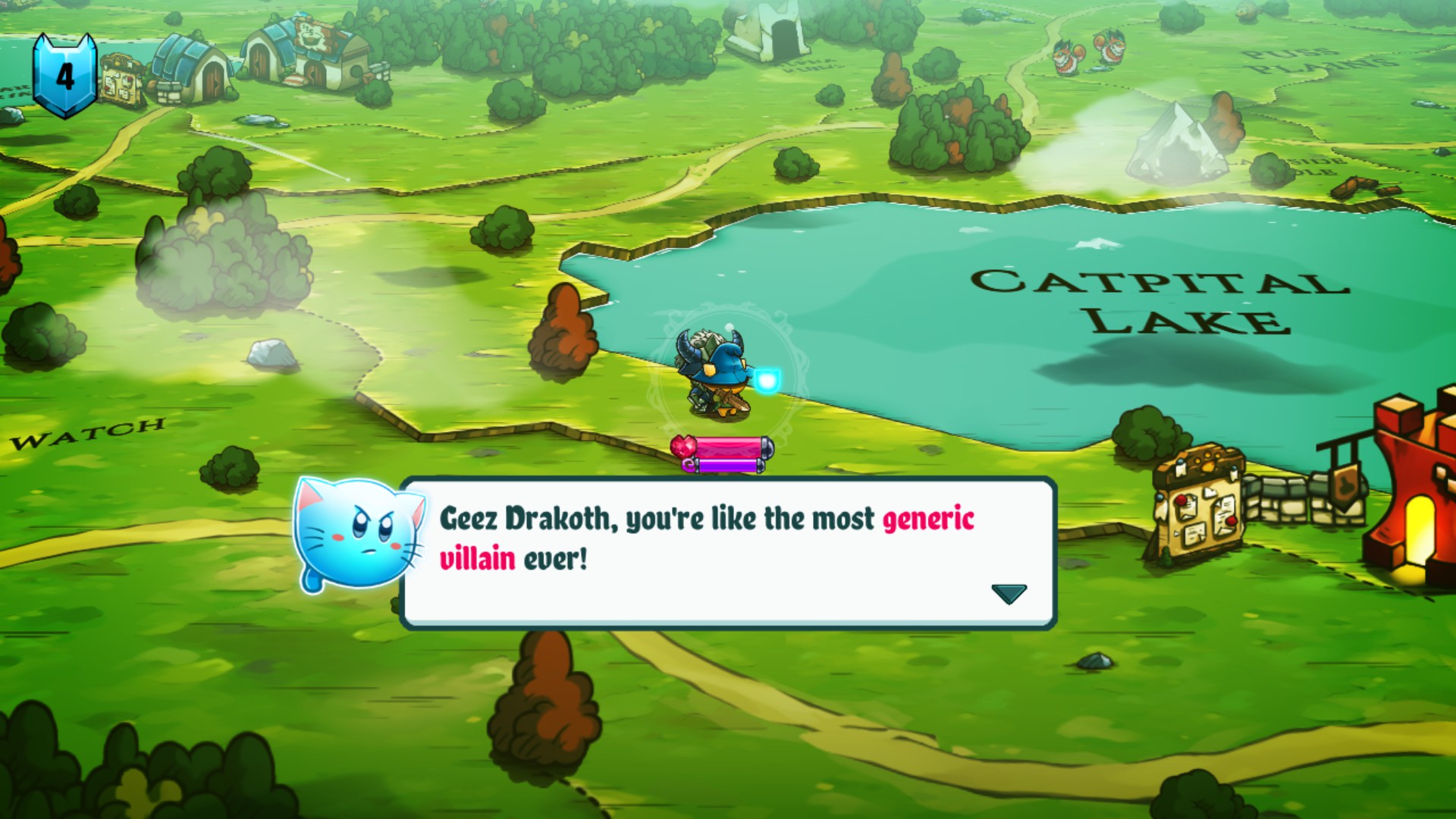
A decent majority of the side-quests in Cat Quest tell random stories with little to no relation to the adventure, which would be fine if they were all self-contained, but many of these tales are often made to mock the very thing they ask you to do. When it comes to parody and imitation, there is often a very thin line between one and the other that becomes harder to distinguish the more times you carelessly cross the boundary. However, when you recognize the dilemma by stating it bluntly and then have the player perform the same task anyway, the result doesn’t make the instance clever; it just makes you look like you are acknowledging what you did was dumb. Perhaps that reaction is harsh, but it really cannot be communicated any other way.
One example of this instance is the Twin Towns where you perform the same side-quest twice where you are sent to fetch something, and then you are ambushed. Upon reaching the exact same coordinates, the Navi-like character remarks that you have done this before, so she recommends you get the drop on the enemies rather than simply avoid the encounter altogether. In reality, you’re doing the same quest and killing the same mobs of enemies, probably for the sake of simplifying the quest-design as well as the coding involved; the only difference is a new textbox on display. This example stands out as the most egregious case, but most side-quests aren’t as guilty of this problem.
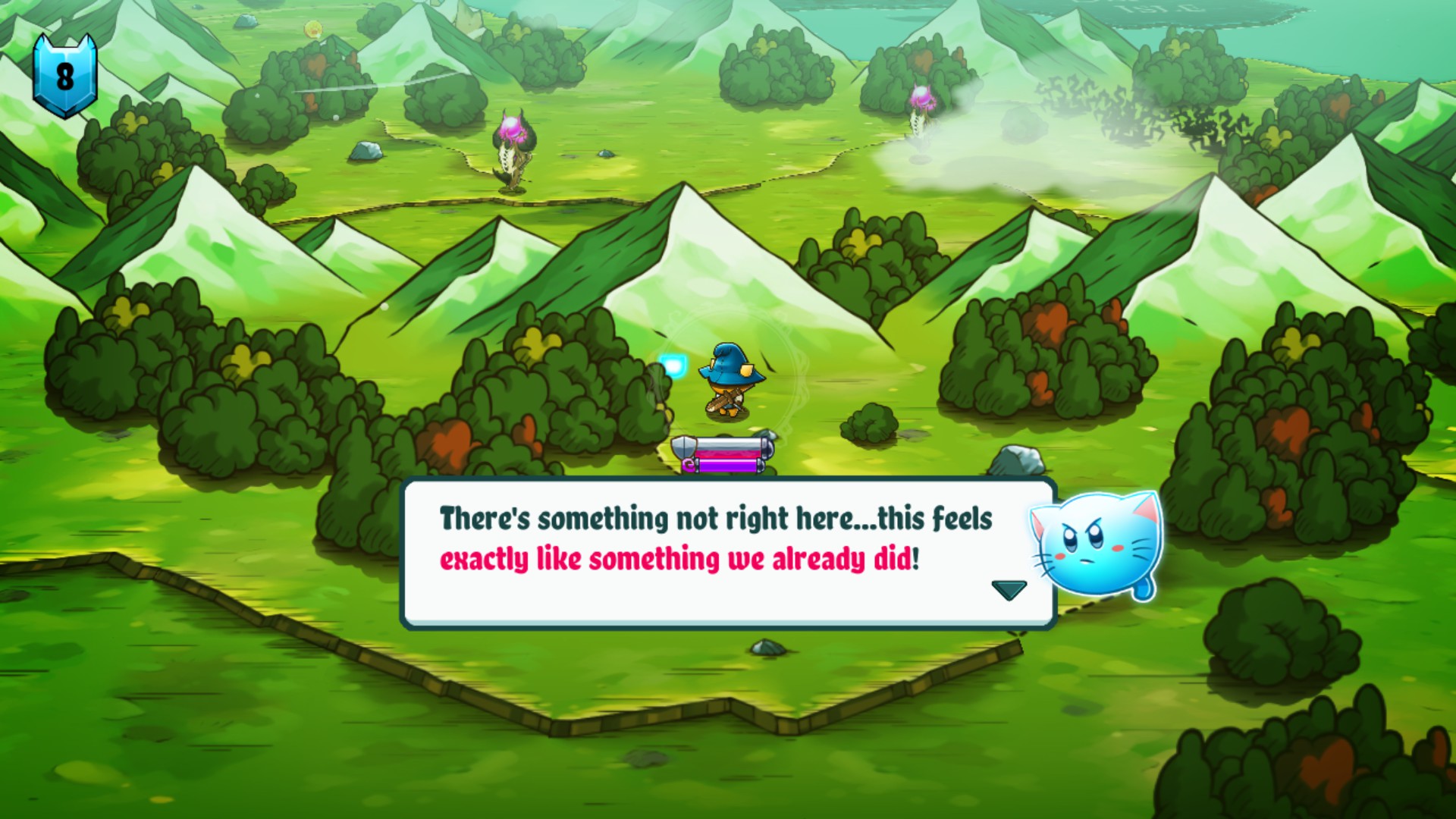
Now you might simply hand-wave away these concerns with the phrase, “It’s a game/story meant for kids,” and you would be justified to accept the narrative as it is. You don’t need an airtight plot for children or adults if the game is simply fun, and Cat Quest is most certainly a good time whether or not your brain cares. However, as someone who read a lot of difficult books on my own and played many games that challenged me, mentally and physically, while growing up there is value in creating media with higher standards for children. The only reason that I draw so much attention to the narrative is that Cat Quest and its sequel want to emphasize it as much as the other half the adventure. Thankfully, the sequel does a much better job in this regard as it keeps a tighter leash on its immersion.
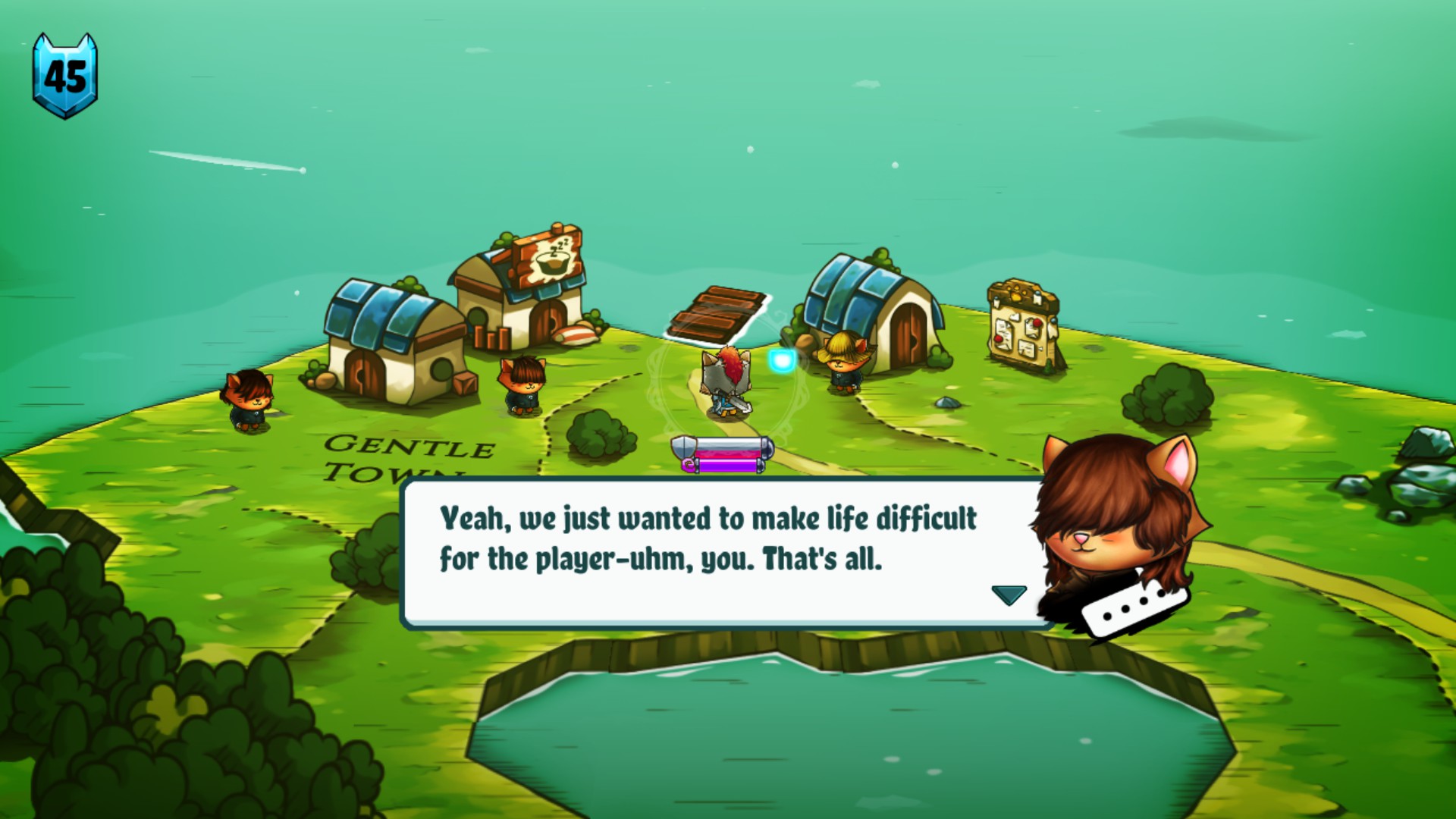
Cat Quest 2: In Cat or Dog Years, a Couple of Years Can Mean a Lifetime
Before we continue on with those improvements, we should discuss the many other elements about the sequel itself. On first impressions, Cat Quest 2 appears to simply be more of the same with added gameplay polish and a local-cooperative companion. (As a side note, Steam users can use the recent “Remote Play Anywhere” feature to play Cat Quest 2 online,but the second player will likely have to play as a mage due to any latency problems.) After the first few dungeons, however, the many improvements from the combat alterations, the overall dungeoneering experience, and the more-tolerable difficulty curve make the sequel worth every second. If it wasn’t for the fact that the previous game had its own ideas, Mew Difficulty options—which will be later added to Cat Quest 2—and its own simple, yet touching, yarn of a tale, then you wouldn’t feel guilty for skipping right to the good stuff.
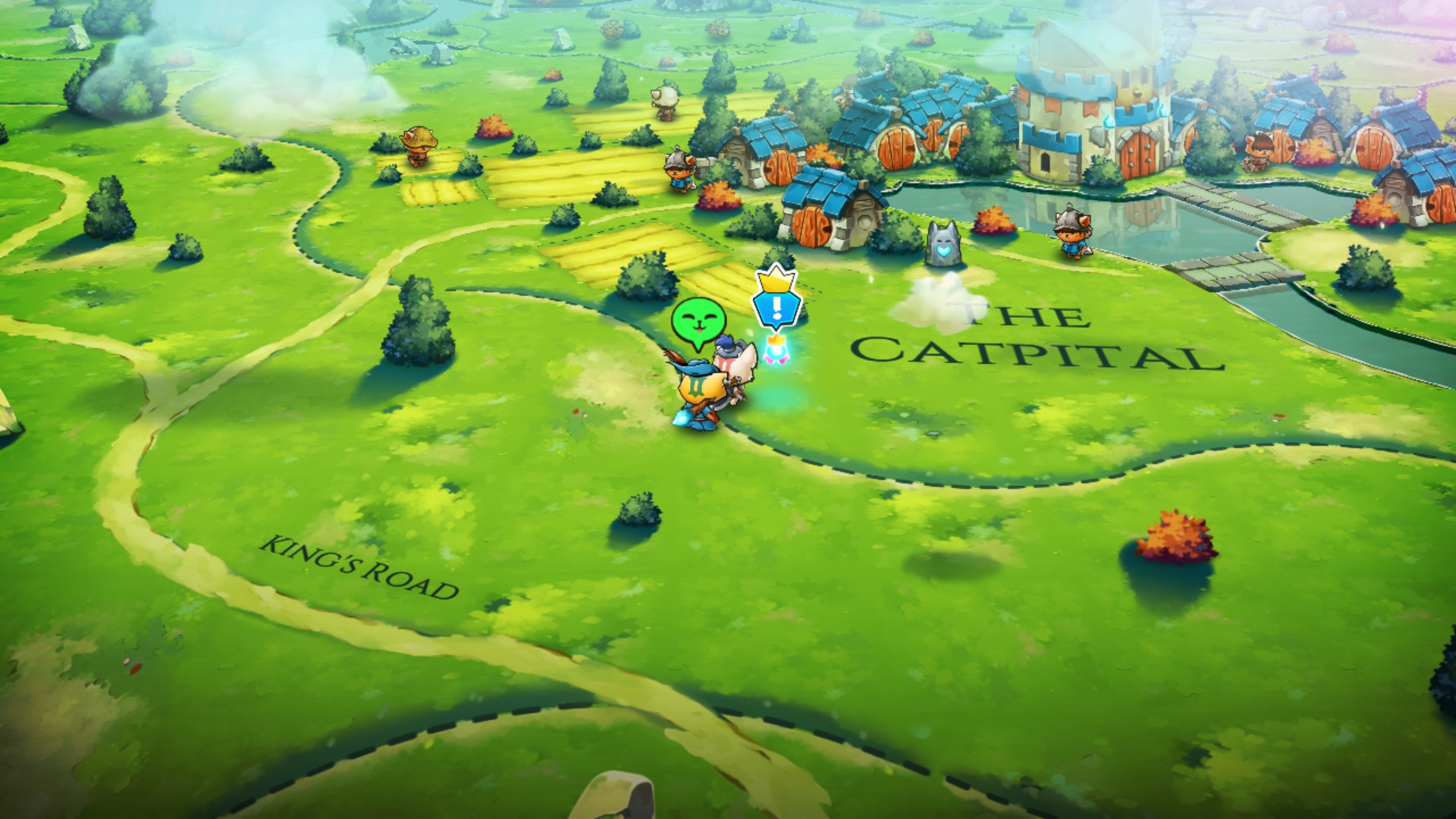
Now because the gameplay itself is largely the same as before, there is no need to go over the same issues that were previously mentioned other than to state that they are still present. There are a few new mechanics added to remove as much downtime as possible such as limited warp-points and the previously mentioned changes to the upgrade system with Kit Kat selling armor upgrades whereas Hotto Doggo-san sharpens your swords. Additionally, there are a few new spells and two extra abilities for combat, but nothing added here will change your mind if the original gameplay doesn’t interest you. That being said, it’s okay for an old dog not to have any new tricks–except when that magic trick happens to leave nasty surprises, but Cat Quest was never that kind of game.
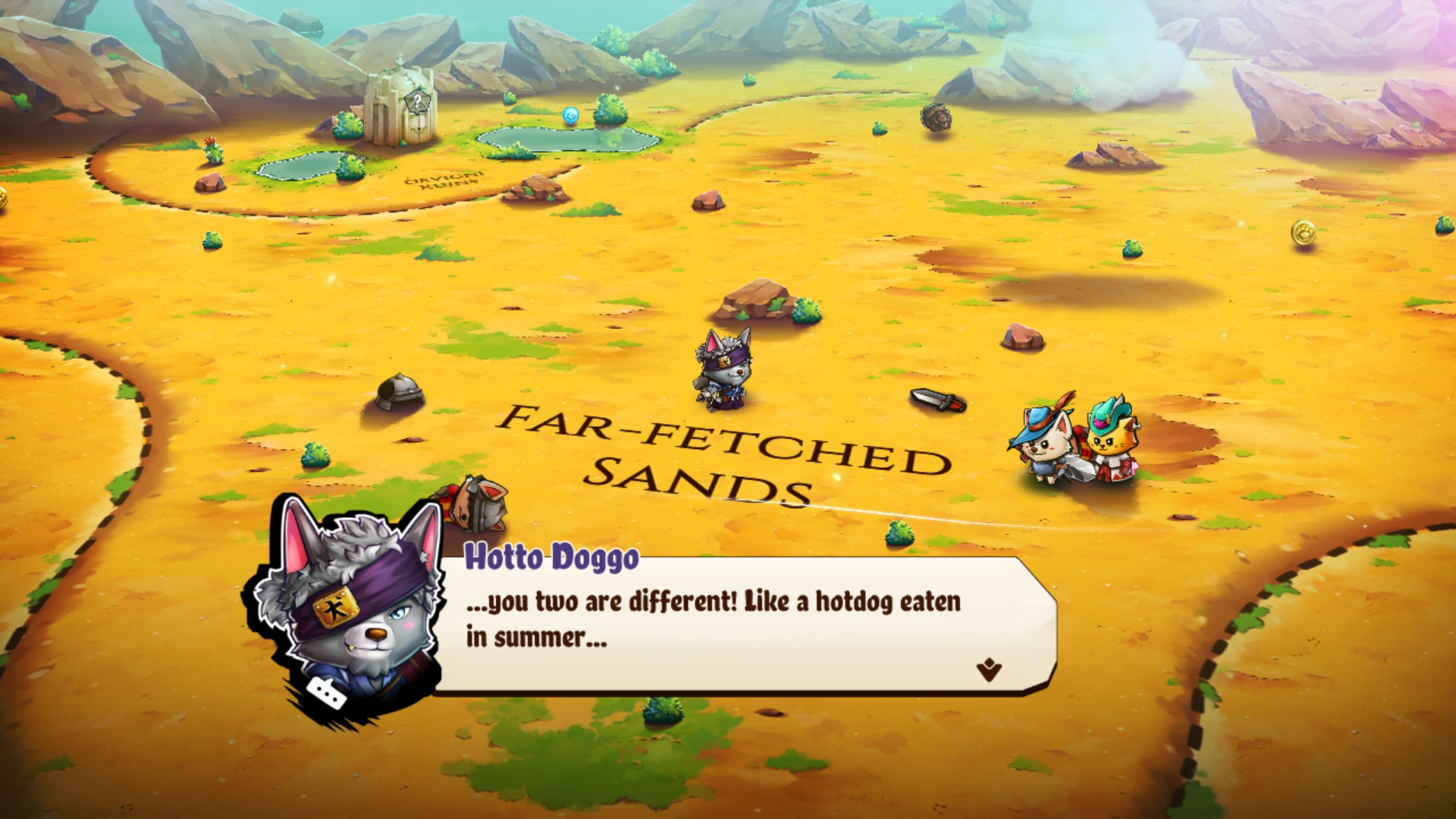
As mentioned beforehand, the game does offer a higher quality PC port with a few more options to tweak and the removal of that annoying circle around the character, but you cannot use the same pause menu for magical spells. The mobile version does still use the same system, so it’s not a case of something being completely forgotten with the new changes. If there is any reason behind its removal on other platforms, it’s most likely the simple fact that you must always have a companion present, so the game doesn’t want to interrupt one player while the other is fighting.
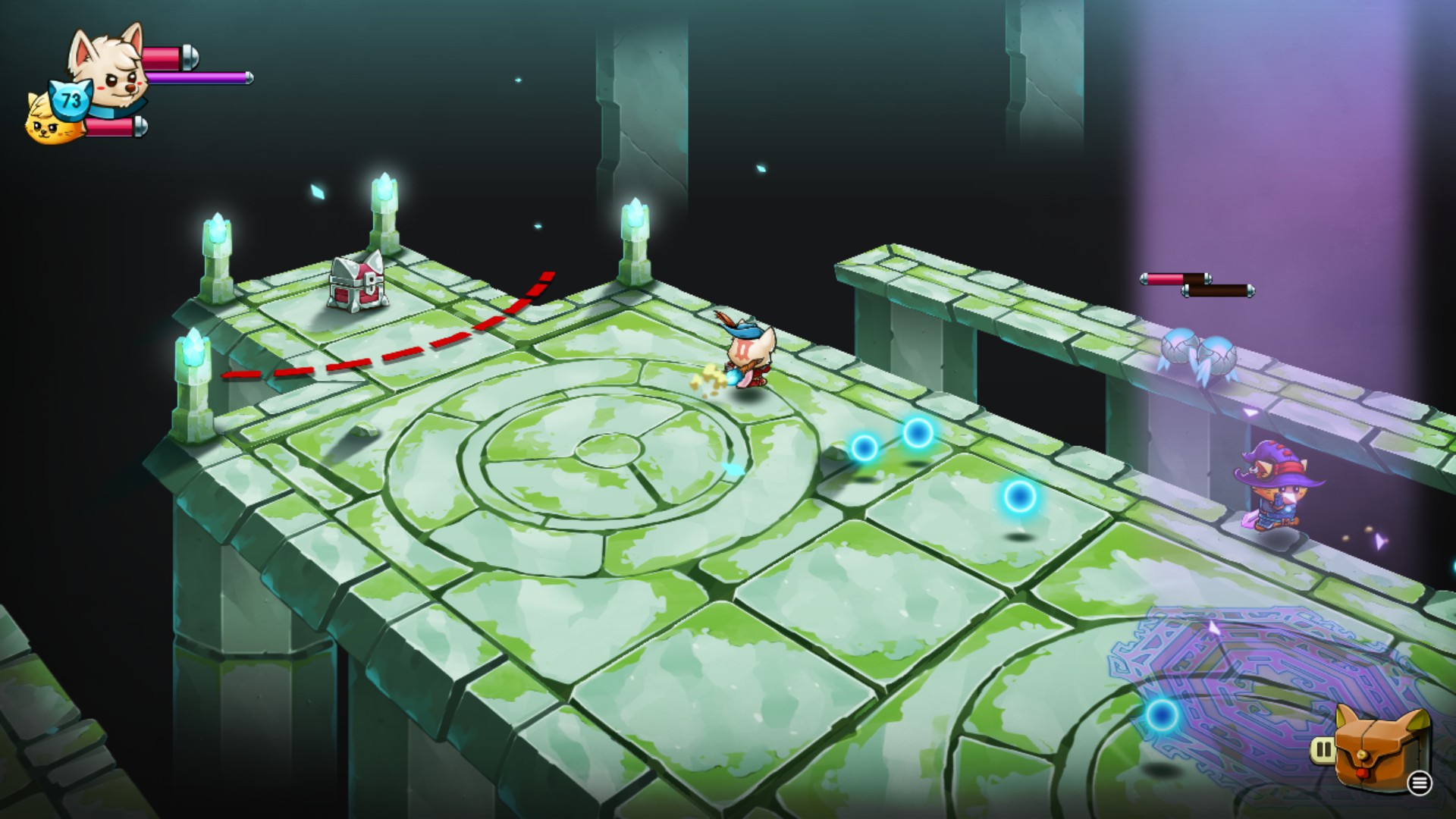
For your die-hard loners like myself, although the companion cannot be removed, the game won’t force you to babysit the AI as the game will be generous enough to have the companion avoid traps and play more defensively during combat. Together, you will deal far more damage compared to the previous game, but the AI won’t carry you if you aren’t playing well or you don’t manage both sets of equipment. Speaking of equipment, you can now wield staffs with projectile attacks and heavy melee weapons that deal more damage but have slower attack speeds. One problem the companion does add is another character to cast screen-nuking spells on top of all the other enemies who now have small projectile attacks of their own and their physical attacks no longer show you the red-outline as they wind-up the animation. Anyway, instead of viewing the second character as a liability, the game treats it more like an extra life during combat to give you another chance at overcoming a dungeon ten to twenty levels above you.
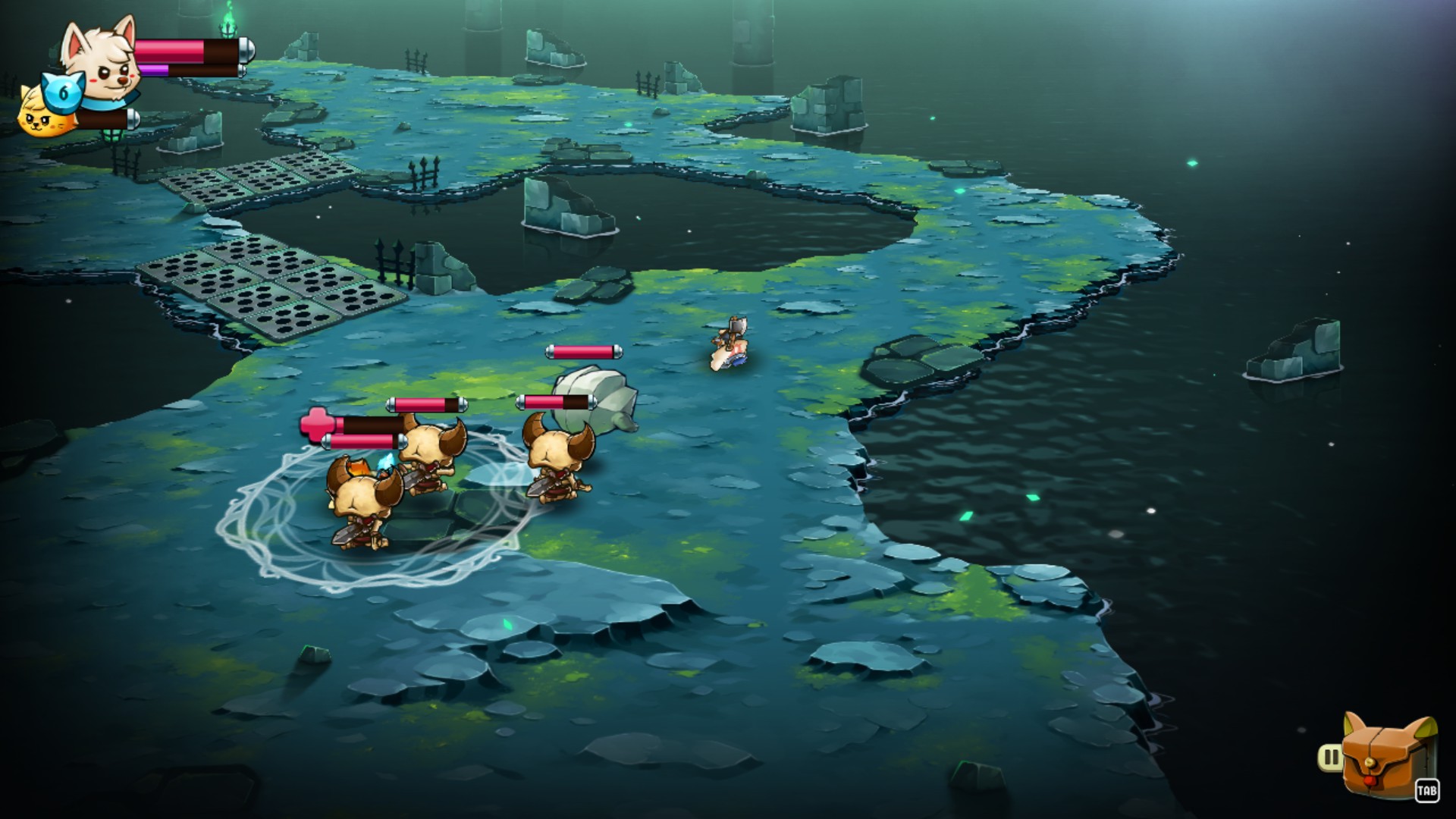
Dungeons are something I have purposely omitted from discussing until now because the quality of dungeons in Cat Quest 2 far, far exceeds the mindless corridors of enemies from the original. While there were fifty-two dungeons in the original game, they all felt identical with one another due to the fact that they were all long hallways with enemies to kill. Another problem was that, due to the seemingly random nature of the level-scaling of these dungeons, you had to go out of your own way to find another place to grind when your gear was rubbish. The sequel, however, offers seventy-three new dungeons with some necessary variety from gauntlet challenges, traps, some simple puzzles, and a few combinations of these categories. This one aspect alone, more so than the slight combat tweaks, is why the idea of a remake within the sequel would be so appealing to me because the previous dungeons would have benefited so much from all these improvements.
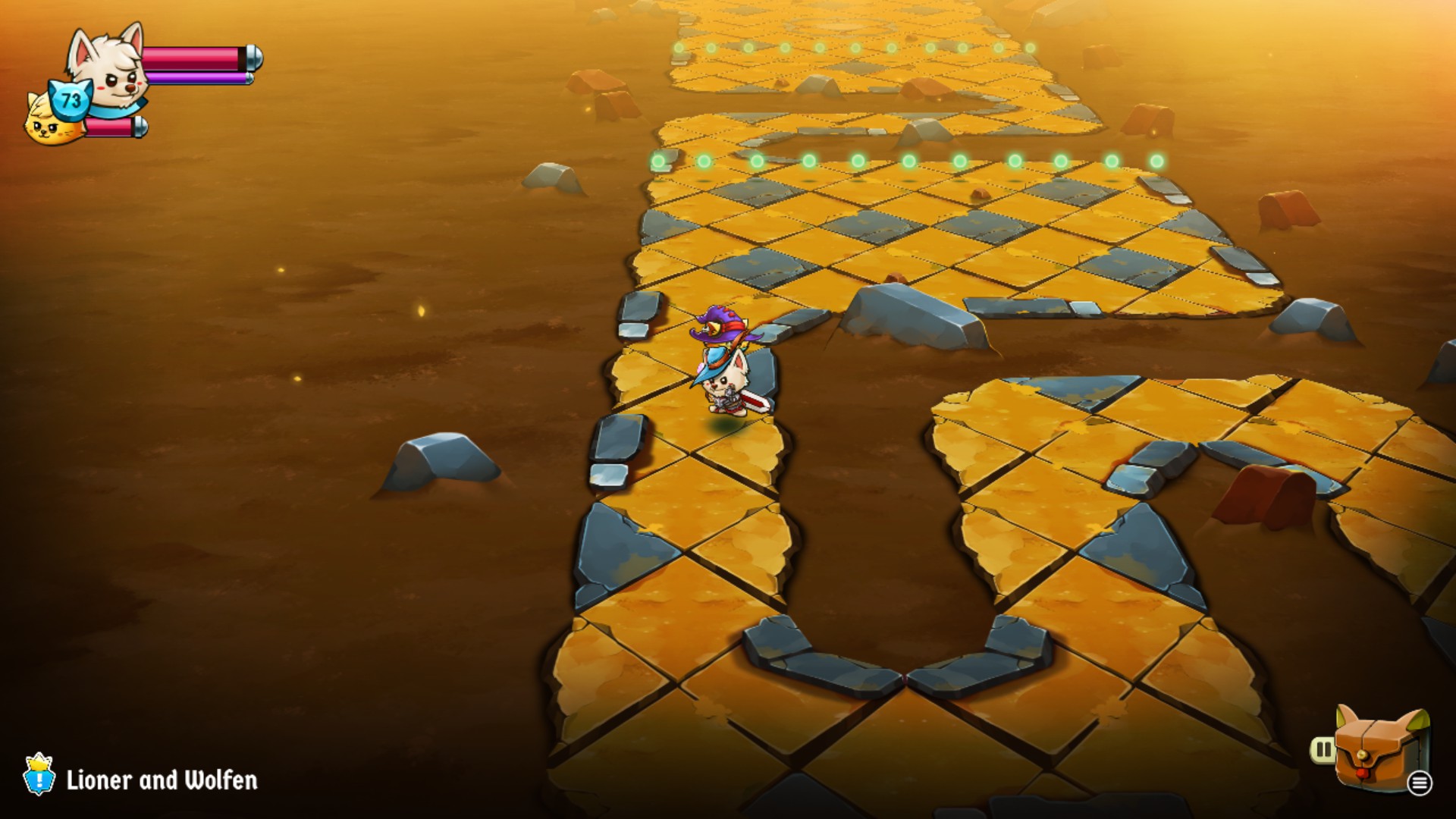
Other than those important changes to the gameplay, the overall experience remains largely the same as before, so if you enjoyed Cat Quest in spite of its issues, then you will most certainly enjoy the sequel equally as much. However, what really elevates Cat Quest 2 beyond its predecessor is how much the writing itself has improved between two games.
Of Purrsecution & Dogmatism
If you were to ask me how I would feel about a cutesy game full of puns tackling more mature subject matters like persecution, prejudice and dogmatic beliefs about others during the conflicts of war, then I don’t think I would have expected Cat Quest 2 to handle the idea as gracefully as it did. What is even more surprising is that the execution never feels patronizing simply because it was a game meant for younger audiences. Instead, the game alludes to these ideas with more nuance to the situation from both sides of the conflict rather than beating the idea over your head.
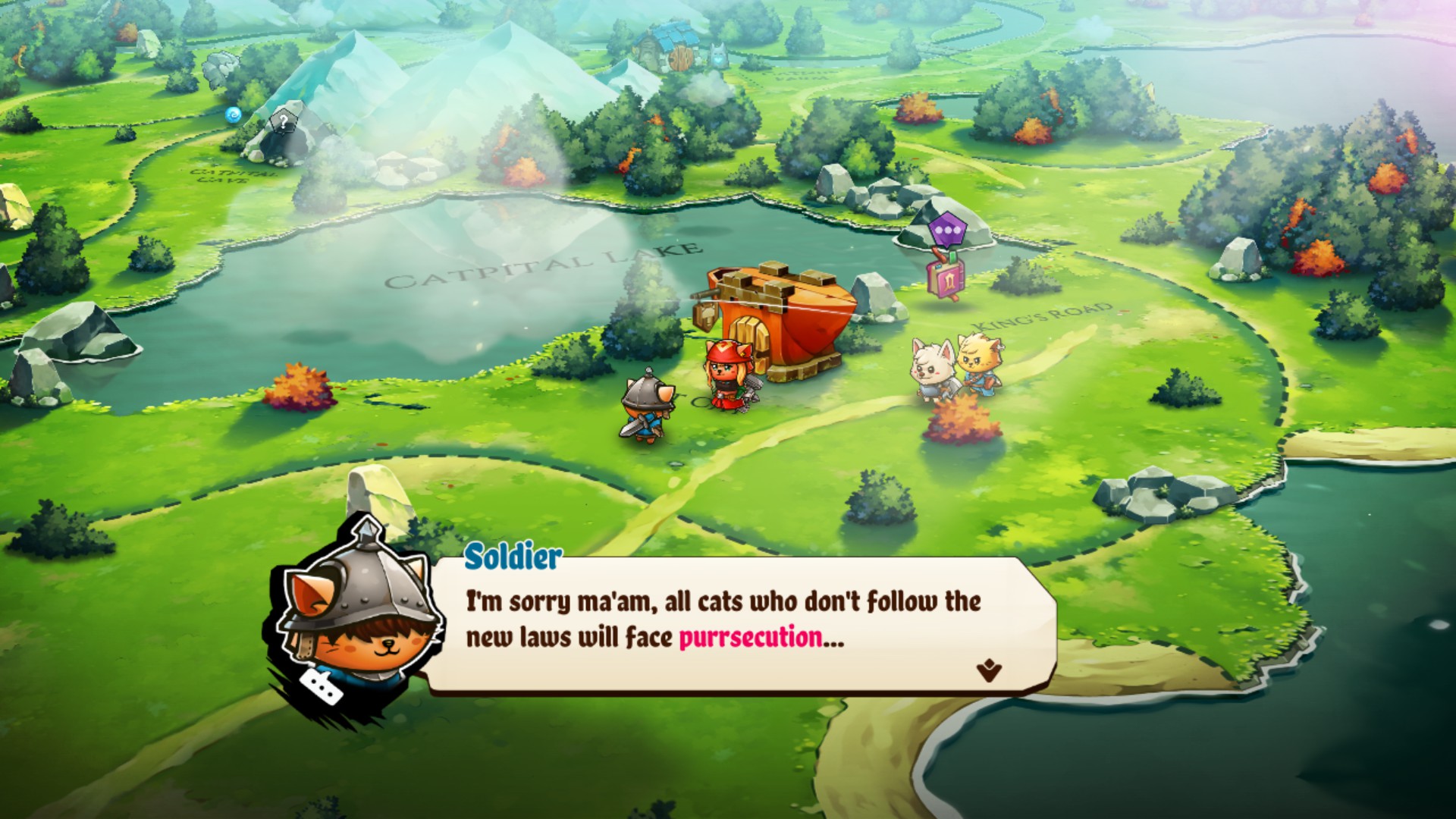
One of the biggest changes between both games is the consistency of side-quests to come back to these thematic subjects, which gives their presence a more integral role in the story. You might have one side-quest showcasing how far the sorcerer cats were pushed when one of them wanted to change history, or you might have another side-quest to smuggle out a stray cat or dog from a family that wanted to do the right thing even though they were supposed to be mortal enemies. While these scenarios sound largely serious, the game never forgets to laugh off these darker stories, which makes their overall impressions on the player all the more impactful. Almost every side-quest comes back to this idea, even when it’s absurd like the Doge Knight fighting off a Cat-Dog reject who wants to make everyone speak in cat puns.
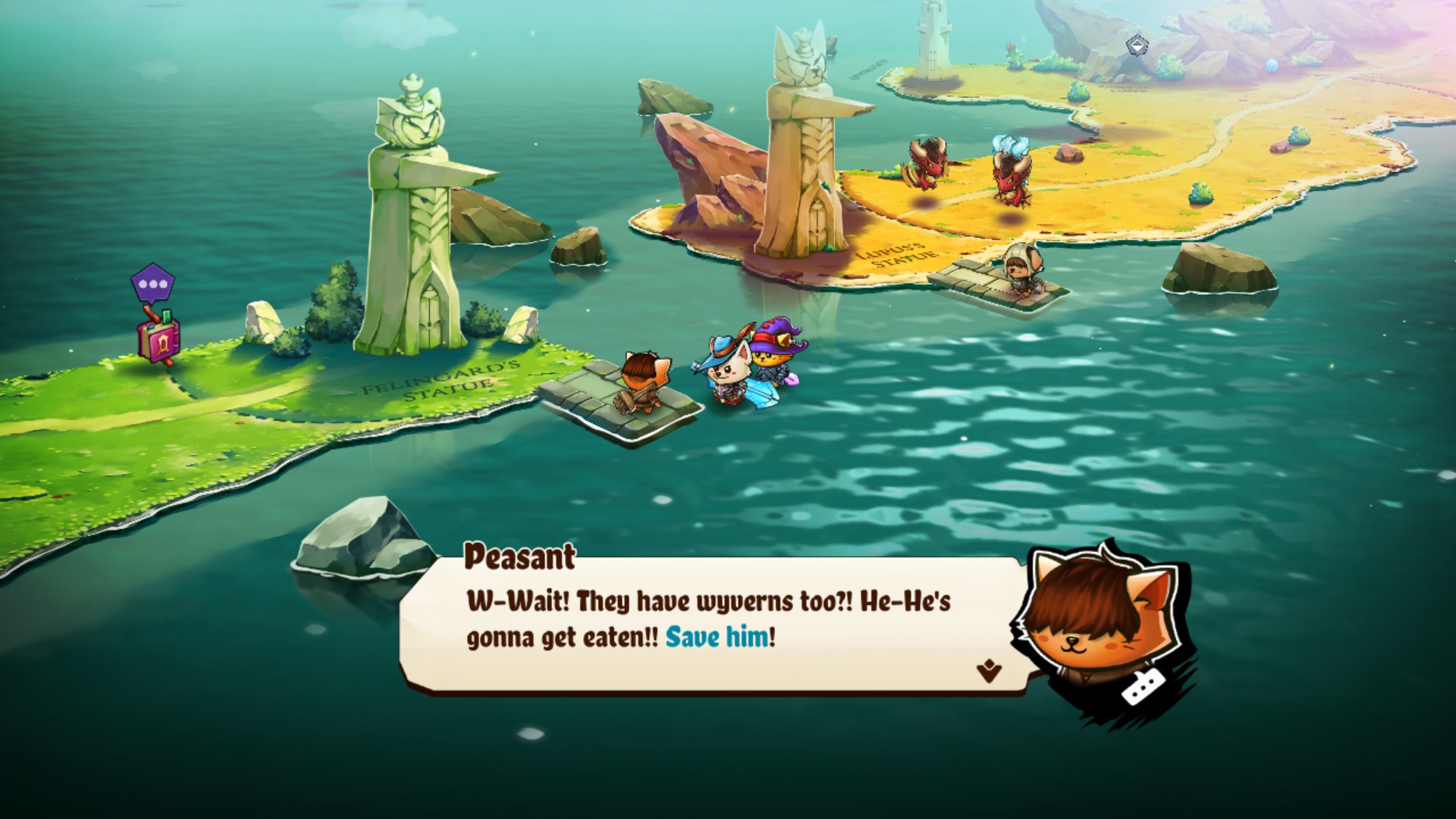
This game is a great example of how well the more serious elements can be balanced out with a comedic tone, and the result is an adventure that almost anyone can enjoy. Even the Twin Towns example from the previous game makes a return, but the execution of that side-quests leaves a far greater impact on the player’s role in the story. The end result of all this extra care and time spent to make a more coherent adventure makes for a much more enriching storyline, even for one about dogs and cats living together without any hysterics.
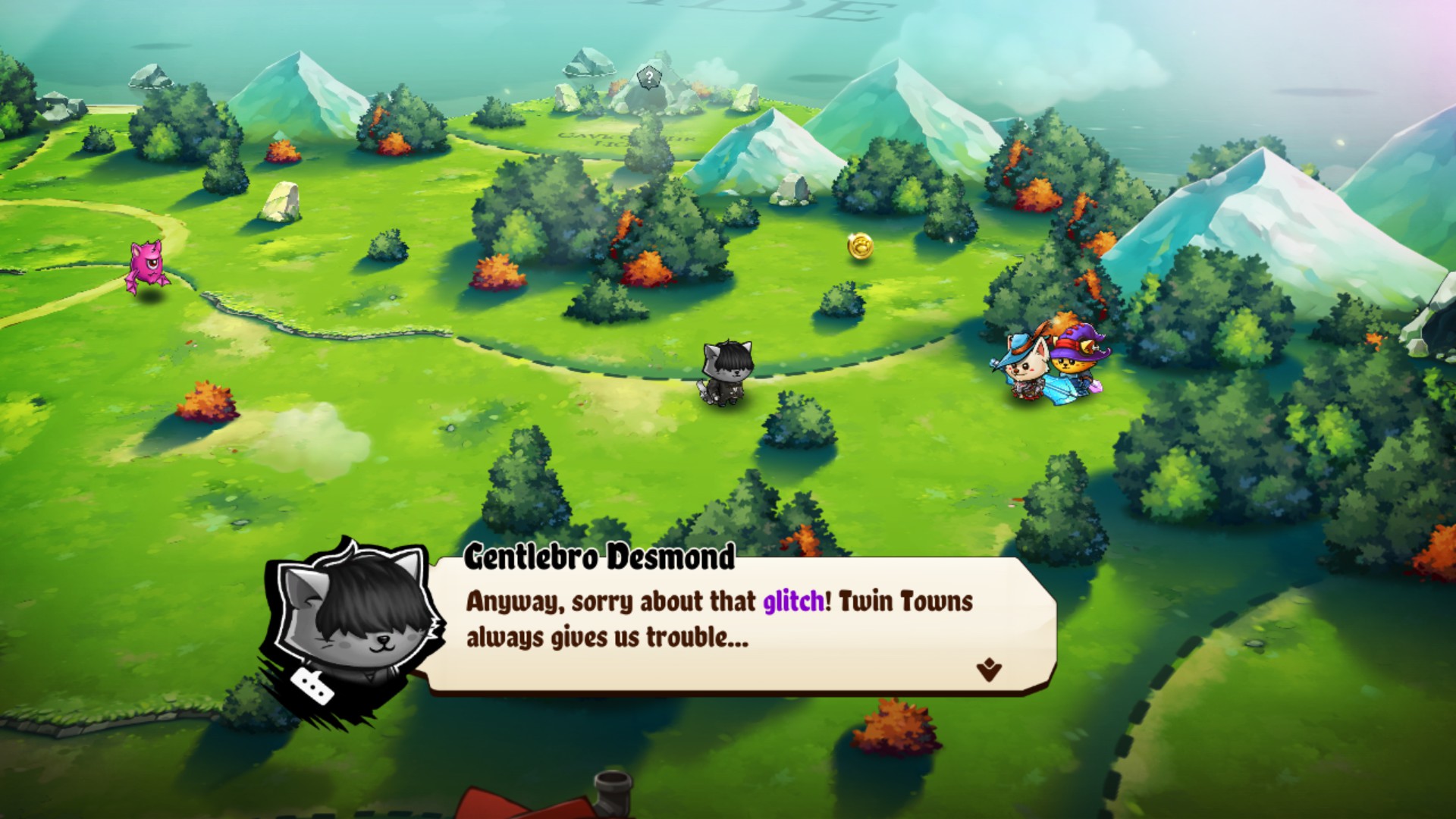
Much like the previous game, the actual storyline of Cat Quest 2 is smarter than you might initially expect, which makes those revelations all the more surprising. Many returning characters from before play some role in the adventure, even major characters like Drakoth, but there are also new characters to expand upon previous stories as well as silly cat-cameos such as Gordon Ramsey (Pawdon Ruffsey.) Instead of playing as the Dragonblood once again, you are playing as one of two Kingbloods returning to your kingdoms in war with one another after an unspecific amount of time between the two games. Both lands are under the tyranny of two equally unjust kings, Lioner the Purrsecutor and Wolfen the Labrathor, who seek the total destruction of one another in the pursuit of the Kingsblade for power. Their development over time makes them the perfect foils to the player(s) who seek to unite the lands for everyone because of their inability to change their own perspectives on the world. This moment, among many others, gives the story more to work with than simply telling puns of cats and dogs. (Mind you, there wouldn’t be anything wrong with a game just about said puns.)
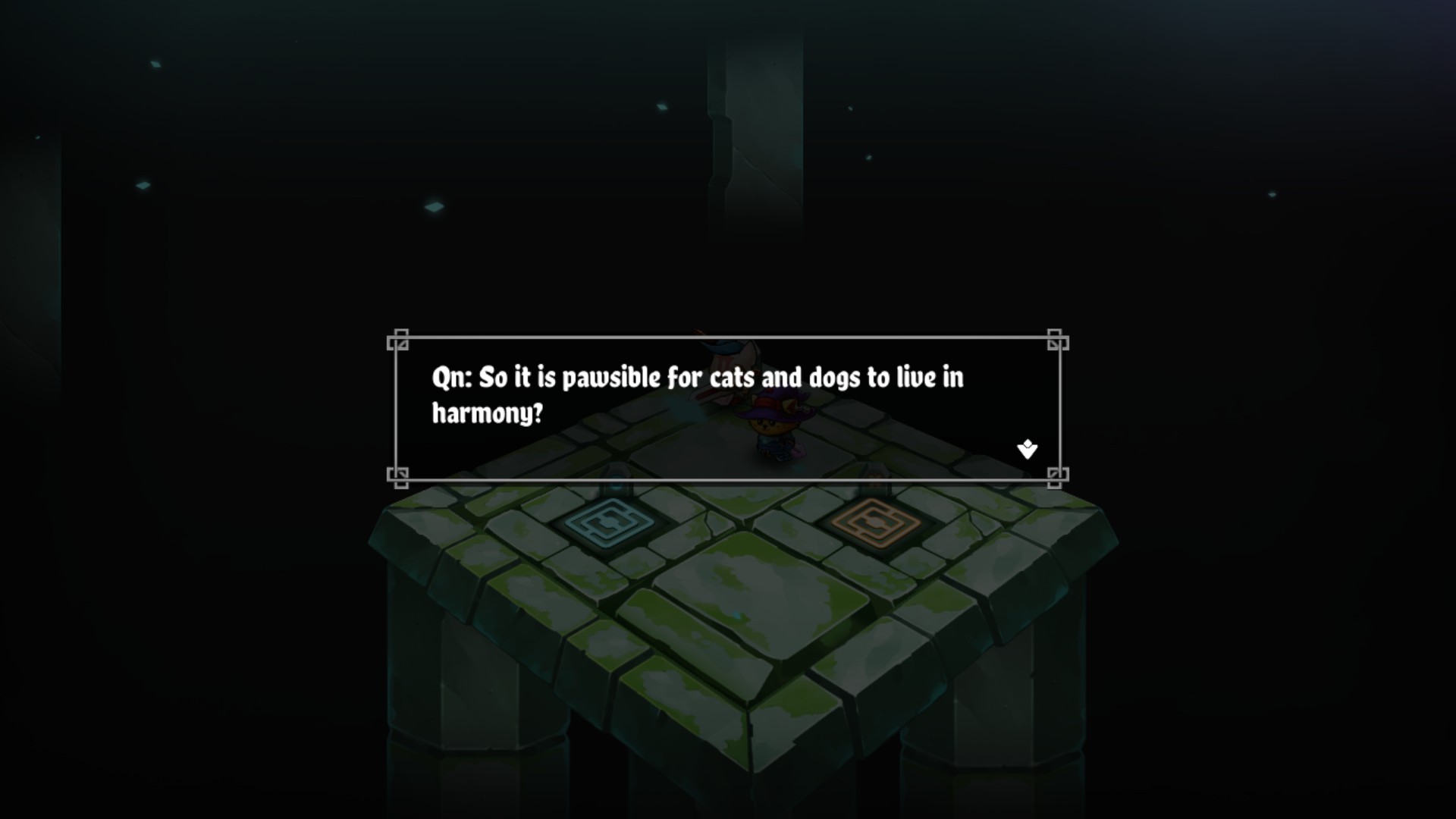
The real cleverness about the storyline is that it focuses around the innate dispute between cats and dogs never getting along, a common joke in real-life now given the epic proportions of two nations at war with one another seemingly since the dawn of time. The idea is so simple, yet the execution is done so tastefully that you’ll accept such a bonkers premise because you see all sides of the conflict. Everyone from Lioner’s obsession with maintaining the most power to Wolfen’s certainty in the rule of fear as a tyrant is given a chance to express what nuances would normally be overshadowed in a game meant for kids. Sometimes these moments of clarity that dogs and cats can get along are genuinely believable because the game never portrays one side as being right or wrong; instead, it shows how two sides struggle to learn to accept one another. The result never makes the game feel too preachy, although the “power of friendship” motif is what you would expect from this type of game, but even then that lesson feels like it had earned it rather than simply stating it.
Verdict: In the Future, We’ll Recall the Cat-tastrophy of These Great Games
For all the many mistakes made along the way, Cat Quest is a series that I have come away with far greater appreciation than I would have ever imagined. Even when considering only the first entry, the game itself manages to do so many things right that it is worth playing it for yourself, and together they make for one epic adventure that anyone with the faintest interest should give a chance. Whether you’re a runt of a gamer, a purebred RPG fan, or somewhere in-between, Cat Quest 1 and 2 will be a purr-fectly good time, and that’s not lion. (Oh no, these jokes are becoming an epundemic! Someone send help!)
